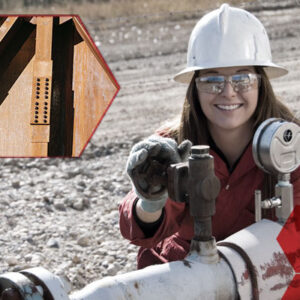Introduction
Cathodic protection is a corrosion prevention technique used to mitigate or halt the corrosion of metallic structures and equipment. Corrosion is a natural electrochemical process that occurs when metals are exposed to environmental elements like moisture, oxygen, and chemicals. This process leads to the deterioration of the metal’s properties and structural integrity over time.
Cathodic protection works by making the metal structure the cathode of an electrochemical cell, thereby diverting the corrosion reaction from the protected structure to another more easily corroded structure, often called an anode. This technique helps preserve the integrity and prolong the lifespan of the protected metal, ensuring the functionality and safety of critical infrastructure such as pipelines, tanks, bridges, ships, and offshore platforms.
Historical Background and Evolution of Cathodic Protection Techniques

Early Developments
Early Observations (19th Century): In the 1820s, Sir Humphry Davy noted that corrosion decreased when iron was in electrical contact with a more noble metal.
Discovery of Sacrificial Anodes (early 20th Century): Around the early 1900s, researchers discovered that attaching a more active (sacrificial) metal, like zinc or magnesium, to the structure to be protected could effectively serve as an anode and prevent corrosion.
Modern Developments
Impressed Current Systems (Mid-20th Century): Advances in the mid-20th century led to the development of impressed current cathodic protection systems. These systems use an external power source to provide a continuous protective current to the structure, improving control and efficiency.
Evolution of Coating Technologies: Concurrently, coatings and materials science advancements complemented cathodic protection, allowing for a more integrated approach to corrosion prevention.
Computer-Aided Design and Monitoring (Late 20th Century onwards): The advent of computers and sophisticated monitoring systems enabled precise design, implementation, and ongoing monitoring of cathodic protection systems, optimizing their efficiency and effectiveness.
Cathodic protection (CP) is a widely used technique for preventing corrosion in various metallic structures, particularly in the context of infrastructure such as pipelines, tanks, offshore platforms, and bridges. It involves utilizing electrochemical principles to control the corrosion of a metal surface by making it the cathode of an electrochemical cell.
Principles of Cathodic Protection
Electrochemical Principles Underlying Cathodic Protection
Electrochemical Reactions: Cathodic protection relies on the basic electrochemical principle that corrosion of a metal involves oxidation at the anode and reduction at the cathode. At the anode, metal atoms are ionized and released into the environment, causing corrosion. At the cathode, reduction reactions occur, consuming electrons and preventing metal corrosion.
Galvanic Cell Formation: Cathodic protection exploits the creation of a galvanic cell. In this setup, two different metals or areas on the same metal with varying electrochemical potentials are connected in an electrolyte (the environment where corrosion occurs). The metal to be protected becomes the cathode, where reduction reactions occur, thus preventing corrosion on the protected surface.
Galvanic and Impressed Current Cathodic Protection Mechanisms
Galvanic Cathodic Protection: Galvanic cathodic protection employs a sacrificial anode made of a metal with a higher electrochemical potential than the structure to be protected. When connected to the structure, a galvanic cell is formed. The sacrificial anode corrodes sacrificially, releasing electrons that flow through the electrolyte to the structure, effectively protecting it from corrosion. Common sacrificial anode materials include zinc, aluminum, and magnesium.
Impressed Current Cathodic Protection: In impressed current cathodic protection, an external power source (rectifier) is used to provide a controlled direct current (DC) to the structure. The cathode (metallic structure) is connected to the negative terminal, and inert anodes (typically made of mixed metal oxide coatings on titanium or other materials) are connected to the positive terminal. The DC current supplies electrons to the cathode, preventing corrosion. This method is used when the structure is large or the environmental conditions require a more controlled and adjustable protection.
Monitoring and Maintenance
Importance of Regular Monitoring
Regular monitoring is a crucial aspect of cathodic protection (CP) systems for corrosion prevention. It ensures that the CP system continues to function effectively and prevents corrosion of the protected structure. The importance of regular monitoring can be highlighted through the following points:
System Performance Verification: Regular monitoring allows for the verification of the cathodic protection system’s performance. By evaluating the potential difference between the protected structure and a reference electrode, it can be confirmed whether the system is providing adequate protection against corrosion.
Early Detection of Issues: Monitoring helps in early detection of any deviations or abnormalities in the CP system. Timely identification of issues allows for prompt corrective measures to be taken, preventing potential damage and maintaining the system’s efficiency.
Optimization of Operation: Continuous monitoring enables the fine-tuning and optimization of the cathodic protection system. Adjustments can be made based on monitoring data to ensure optimal performance and energy efficiency of the CP system.
Cost-Effectiveness: Monitoring helps in managing costs effectively. It allows for proactive maintenance and minimizes the risk of costly repairs or replacements due to unchecked corrosion.
Long-Term Asset Preservation: Monitoring over the long term helps in extending the life of the protected structure by preventing corrosion-induced deterioration. This prolongs the service life of the asset and saves resources that would otherwise be required for replacement.
Data for Decision-Making: Monitoring provides valuable data that aids in making informed decisions regarding the maintenance, repair, or modification of the cathodic protection system. This data-driven approach ensures efficient resource allocation and management.
Techniques for Assessing Cathodic Protection Performance
Assessing the performance of cathodic protection systems is essential to ensure their effectiveness in preventing corrosion. Various techniques are employed for this purpose, including:
Potential Measurements: Measurement of the electrical potential at specified locations on the protected structure using reference electrodes. Comparison of these potentials with standard values helps assess the level of protection provided by the CP system.
Current Density Measurement: Measurement of the current density delivered by the CP system to the structure. Current density indicates the amount of protective current supplied and helps evaluate the sufficiency of cathodic protection.
Structure-to-Electrolyte Potential Surveys: Conducting potential surveys across the structure to assess potential variations and identify areas where additional protection may be needed.
Close-Interval Potential Surveys: Conducting potential surveys at close intervals to monitor changes in potential over time, enabling the detection of trends that may indicate potential issues with the CP system.
Electrical Resistance Measurements: Measurement of the electrical resistance between the anode and the structure. Deviations from expected resistance levels may indicate a need for maintenance or further investigation.
Visual Inspections and Corrosion Rate Monitoring: Regular visual inspections of the structure to assess signs of corrosion and monitoring of corrosion rates using corrosion probes or coupons.
Non-Destructive Testing (NDT): Utilization of NDT techniques such as ultrasonic testing, radiographic testing, or magnetic particle testing to assess the integrity of the structure and detect any defects or corrosion-related issues.
Soil Resistivity Testing: Measurement of soil resistivity to ensure that the soil’s resistivity is within an acceptable range for effective cathodic protection.
Emerging Technologies and Future Trends
New Developments in Cathodic Protection Technology
Cathodic protection (CP) is an electrochemical technique used to prevent corrosion in metal structures by making the structure the cathode of an electrochemical cell. As technology advances, new developments in cathodic protection have emerged, enhancing its efficiency, effectiveness, and application. Several notable advancements in cathodic protection technology are:
Advanced Anode Materials: Researchers are developing new anode materials with improved properties, such as higher current capacity, longer lifespan, and better resistance to harsh environments. Materials like mixed metal oxide (MMO) and conductive polymers are being explored for their superior performance.
Remote Monitoring and Control: Integration of sensor technology and IoT (Internet of Things) allows real-time monitoring and control of cathodic protection systems. This enables proactive maintenance, immediate response to anomalies, and overall optimization of the CP process.
Machine Learning and AI Integration: Machine learning algorithms and artificial intelligence are being employed to analyze vast amounts of data generated by CP systems. These technologies help predict corrosion rates, optimize CP parameters, and enhance system efficiency.
Electrochemical Sensors and Probes: Innovative electrochemical sensors and probes are being developed to provide accurate and localized corrosion data. These sensors help in determining the effectiveness of the cathodic protection system and allow for targeted interventions.
Environmentally Friendly Approaches: Eco-friendly and sustainable approaches are gaining traction, such as biocathodic protection using microbial fuel cells or utilizing renewable energy sources to power CP systems. These methods aim to minimize the environmental impact of cathodic protection.
Potential Advancements and Future Directions in the Field
Looking ahead, the field of cathodic protection is poised for significant advancements and future trends, which will shape the corrosion prevention landscape. Key potential advancements and future directions include:
Nanostructured Coatings and Materials: Integration of nanotechnology in cathodic protection involves developing nanostructured coatings and materials that offer enhanced corrosion resistance. These nanostructures provide a higher surface area for electrochemical reactions, improving protection efficiency.
Smart Coating Systems: Smart coatings with embedded sensors and self-healing properties are anticipated to become mainstream. These coatings can autonomously detect and repair minor damages, thereby extending the life of the protective layer and reducing maintenance needs.
Augmented Reality for Inspection and Maintenance: Utilizing augmented reality (AR) for inspection and maintenance purposes can revolutionize the way cathodic protection systems are managed. AR can provide real-time visualizations of the system’s status and guide maintenance activities.
Electrochemical Energy Storage Coupling: Integrating cathodic protection systems with electrochemical energy storage, such as batteries or supercapacitors, can enable energy harvesting and storage from the electrochemical reactions. This dual-purpose approach enhances sustainability and efficiency.
Global Standardization and Regulations: As the importance of corrosion prevention grows, there will likely be a push for global standardization and regulations to ensure the effective and uniform implementation of cathodic protection techniques across various industries and regions.
Conclusion
In conclusion, Cathodic Protection Techniques play a pivotal role in preserving the integrity and longevity of metallic structures, safeguarding them from the detrimental effects of corrosion. Through proactive corrosion prevention and management, industries can significantly reduce maintenance costs, enhance safety, and extend the service life of critical infrastructure.
To further enhance understanding and expertise in the field of cathodic protection, individuals and professionals can avail of comprehensive courses offered by the CORCON Institute of Corrosion. These courses provide valuable insights, hands-on training, and the latest advancements in cathodic protection technologies, empowering individuals to contribute effectively to corrosion mitigation efforts and ensure a sustainable and resilient future for our infrastructure. Enrolling in CORCON’s courses equips learners with the knowledge and skills necessary to implement effective cathodic protection strategies, ultimately promoting the advancement and success of corrosion control within various industries.
Image Reference: Freepik
Disclaimer: All trademarks, logos, and brand names are the property of their respective owners. All company, product, and service names used in this website are for identification purposes only. Use of these names, trademarks, and brands does not imply endorsement.















